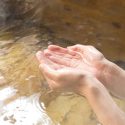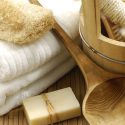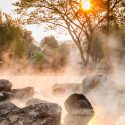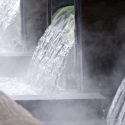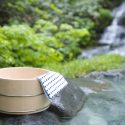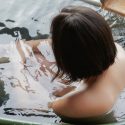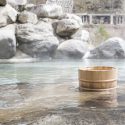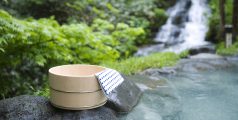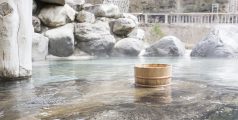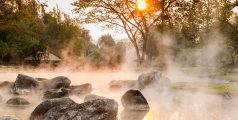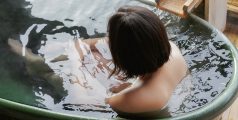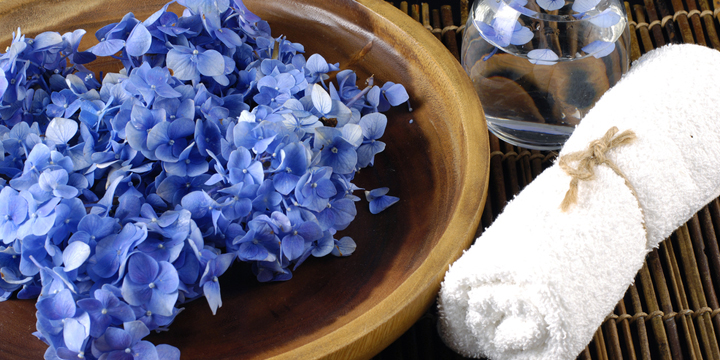
The Surprising Origins of Bathclin!
The Bathclin story takes us back to 1930, but how does our tale begin?
Bath additive
Just before the start of summer in Japan, we have the rainy season. To the agricultural world, this is an extremely important season that our precious plant life could not live without. For we humans, however, the constant damp and humid weather can be a downer. But it was actually due to the rainy season that the very first Bathclin products were born. Join us as we look at the advent of the Bathclin brand and learn how our story began.
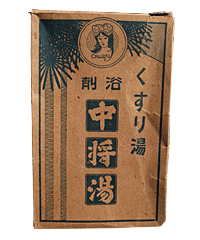 Before Bathclin, we sold an additive at public baths called “Kusuriyu Yokuzai Chujoto.” An employee of Tsumura Juntendo who was working on a medicine for women called “Chujoto” took some of the herbal medicine they were using to their home and put it in the bath (at the time, just a washtub that you had to fill manually). While bathing, they noticed it warmed up their body and even improved their eczema. From then on, they went about developing the herbal medicine as an additive product for bathers in public baths, still recycling leftover ingredients from the medicine. This “Kusuriyu Yokuzai Chujoto” went on to become a massive word-of-mouth success at public baths, just like trending on social media in the present day.
Before Bathclin, we sold an additive at public baths called “Kusuriyu Yokuzai Chujoto.” An employee of Tsumura Juntendo who was working on a medicine for women called “Chujoto” took some of the herbal medicine they were using to their home and put it in the bath (at the time, just a washtub that you had to fill manually). While bathing, they noticed it warmed up their body and even improved their eczema. From then on, they went about developing the herbal medicine as an additive product for bathers in public baths, still recycling leftover ingredients from the medicine. This “Kusuriyu Yokuzai Chujoto” went on to become a massive word-of-mouth success at public baths, just like trending on social media in the present day.
Once customers started using the product, they wanted more and more. And while they were happy with a bath additive that kept them nicely warm, they soon started asking for one suitable for the heat of the summer. Under supervision of the professor Kariyone from Kyoto University, a cool and refreshingly aromatic additive Bathclin was created. The very first Bathclin was actually designed solely with summer in mind!
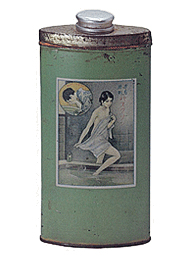 The main difference between the first generation of Bathclin and that of today is that the original was sold as a medicine, while now it is classified as a medicated product. “Kusuriyu Yokuzai Chujoto” was made with herbal medicine, whereas the active components in Bathclin are the same as Japanese onsen: dried sodium sulfate and sodium hydrogen carbonate. The original packaging is designed by Kasho Takabatake, one of the masters of Romanticism during the Taisho Period (1912–1926). It remains a timeless work to the present day.
The main difference between the first generation of Bathclin and that of today is that the original was sold as a medicine, while now it is classified as a medicated product. “Kusuriyu Yokuzai Chujoto” was made with herbal medicine, whereas the active components in Bathclin are the same as Japanese onsen: dried sodium sulfate and sodium hydrogen carbonate. The original packaging is designed by Kasho Takabatake, one of the masters of Romanticism during the Taisho Period (1912–1926). It remains a timeless work to the present day.
The scent of the original Bathclin was that of refreshing pinecones—perfect for summer. In terms of pricing, it cost 50 sen (100 sen = 1 yen) for 150 grams, which would have been roughly enough for 15 uses. Considering that the average cost of entry to a public bathhouse was around 6 sen, this made it a pretty luxurious product.
So, next time when you experience the sultry heat in the continuous rain like the Japanese rainy season, why not blast it away and relax in a refreshingly fragranced Bathclin bath? The time-honored scents and benefits of Bathclin make any bath a treat.
The Advent of Bathclin
Bathclin was born on the 22nd of June in the year Showa 5 (1930), which makes us 89 years old at the time of this writing (July 2018). We have always been called Bathclin, right from the very beginning. Back then, having baths in their own houses wasn’t all that common, and most people still used public bathhouses or sento. At the time, the English-sounding name Bathclin must have sounded pretty progressive as well!The Inception of Bathclin
 Before Bathclin, we sold an additive at public baths called “Kusuriyu Yokuzai Chujoto.” An employee of Tsumura Juntendo who was working on a medicine for women called “Chujoto” took some of the herbal medicine they were using to their home and put it in the bath (at the time, just a washtub that you had to fill manually). While bathing, they noticed it warmed up their body and even improved their eczema. From then on, they went about developing the herbal medicine as an additive product for bathers in public baths, still recycling leftover ingredients from the medicine. This “Kusuriyu Yokuzai Chujoto” went on to become a massive word-of-mouth success at public baths, just like trending on social media in the present day.
Before Bathclin, we sold an additive at public baths called “Kusuriyu Yokuzai Chujoto.” An employee of Tsumura Juntendo who was working on a medicine for women called “Chujoto” took some of the herbal medicine they were using to their home and put it in the bath (at the time, just a washtub that you had to fill manually). While bathing, they noticed it warmed up their body and even improved their eczema. From then on, they went about developing the herbal medicine as an additive product for bathers in public baths, still recycling leftover ingredients from the medicine. This “Kusuriyu Yokuzai Chujoto” went on to become a massive word-of-mouth success at public baths, just like trending on social media in the present day.Once customers started using the product, they wanted more and more. And while they were happy with a bath additive that kept them nicely warm, they soon started asking for one suitable for the heat of the summer. Under supervision of the professor Kariyone from Kyoto University, a cool and refreshingly aromatic additive Bathclin was created. The very first Bathclin was actually designed solely with summer in mind!
What kind of product was the first generation of Bathclin?
 The main difference between the first generation of Bathclin and that of today is that the original was sold as a medicine, while now it is classified as a medicated product. “Kusuriyu Yokuzai Chujoto” was made with herbal medicine, whereas the active components in Bathclin are the same as Japanese onsen: dried sodium sulfate and sodium hydrogen carbonate. The original packaging is designed by Kasho Takabatake, one of the masters of Romanticism during the Taisho Period (1912–1926). It remains a timeless work to the present day.
The main difference between the first generation of Bathclin and that of today is that the original was sold as a medicine, while now it is classified as a medicated product. “Kusuriyu Yokuzai Chujoto” was made with herbal medicine, whereas the active components in Bathclin are the same as Japanese onsen: dried sodium sulfate and sodium hydrogen carbonate. The original packaging is designed by Kasho Takabatake, one of the masters of Romanticism during the Taisho Period (1912–1926). It remains a timeless work to the present day.The scent of the original Bathclin was that of refreshing pinecones—perfect for summer. In terms of pricing, it cost 50 sen (100 sen = 1 yen) for 150 grams, which would have been roughly enough for 15 uses. Considering that the average cost of entry to a public bathhouse was around 6 sen, this made it a pretty luxurious product.
Continuous Evolution of Bathclin
The packaging today is made of recycled papers and comes in an oval shape container that was found to be the easiest to hold from the point of human engineering. Decades of research into bathing and attention to customer feedback have led us to create a whole new lineup of fragrances and products, with more to come in the future. It is not exaggerated to say that Bathclin’s history is part of Japanese bathing history.So, next time when you experience the sultry heat in the continuous rain like the Japanese rainy season, why not blast it away and relax in a refreshingly fragranced Bathclin bath? The time-honored scents and benefits of Bathclin make any bath a treat.






